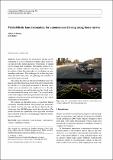Probabilistic lane estimation for autonomous driving using basis curves
Author(s)
Huang, Albert S.; Teller, Seth
DownloadTeller_Probabilistic lane estimation.pdf (11.79Mb)
OPEN_ACCESS_POLICY
Open Access Policy
Creative Commons Attribution-Noncommercial-Share Alike
Terms of use
Metadata
Show full item recordAbstract
Lane estimation for autonomous driving can be formulated as a curve estimation problem, where local sensor data provides partial and noisy observations of spatial curves forming lane boundaries. The number of lanes to estimate are initially unknown and many observations may be outliers or false detections (due e.g. to shadows or non-boundary road paint). The challenges lie in detecting lanes when and where they exist, and updating lane estimates as new observations are made.
This paper describes an efficient probabilistic lane estimation algorithm based on a novel curve representation. The key advance is a principled mechanism to describe many similar curves as variations of a single basis curve. Locally observed road paint and curb features are then fused to detect and estimate all nearby travel lanes. The system handles roads with complex multi-lane geometries and makes no assumptions about the position and orientation of the vehicle with respect to the roadway.
We evaluate our algorithm using a ground truth dataset containing manually-labeled, fine-grained lane geometries for vehicle travel in two large and diverse datasets that include more than 300,000 images and 44 km of roadway. The results illustrate the capabilities of our algorithm for robust lane estimation in the face of challenging conditions and unknown roadways.
Date issued
2011-09Department
Massachusetts Institute of Technology. Computer Science and Artificial Intelligence Laboratory; Massachusetts Institute of Technology. Department of Electrical Engineering and Computer ScienceJournal
Autonomous Robots
Publisher
Springer-Verlag
Citation
Huang, Albert S., and Seth Teller. “Probabilistic Lane Estimation for Autonomous Driving Using Basis Curves.” Autonomous Robots 31.2-3 (2011): 269–283.
Version: Author's final manuscript
ISSN
0929-5593
1573-7527